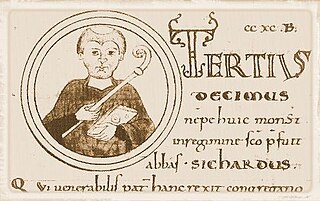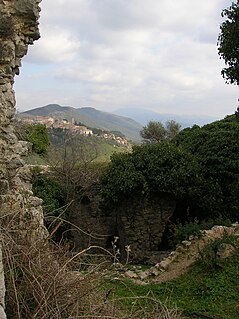
Farfa Abbey is a territorial abbey in northern Lazio, central Italy. It is one of the most famous abbeys of Europe. It belongs to the Benedictine Order and is located about 60 km from Rome, in the commune of Fara Sabina, of which it is also a hamlet.
Farfa is an Italian name which can refer to:

Santa Vittoria in Matenano is a comune (municipality) in the Province of Fermo in the central Italian region Marche, located about 70 kilometres south of Ancona and about 20 km (12 mi) northwest of Ascoli Piceno.

Fara in Sabina, also spelled Fara Sabina, is a comune (municipality) in the Province of Rieti in the Italian region Lazio, located about 40 kilometres (25 mi) northeast of Rome and about 25 kilometres (16 mi) southwest of Rieti.

Montopoli di Sabina is a town and comune (municipality) in the Province of Rieti in the Italian region Latium, located about 40 kilometres (25 mi) northeast of Rome and about 20 kilometres (12 mi) southwest of Rieti. In 2011, it had a population of 4,222.
Teuto was the Abbot of Farfa from about 883 until about 888. His abbacy is the first of a string of very unclear ones that cover the years down to 919 at Farfa. He is known to have succeeded Anselm and been succeeded by Nordepert, but little else is certain. The period of his abbacy had already become obscure when Gregory of Catino was chronicling the abbey's history and editing its charters in the late eleventh century.

Sichard was a 9th century Italian Monk. He was the Abbot of Farfa from c.830 to 842. His abbacy corresponds with a drop in the number of property transactions involving Farfa, perhaps because "[its] wealth was by that time sufficient to cover major building at the abbey itself." Sichard added an oratory to the existing abbey.
Wandelbert was the Abbot of Farfa sometime between 757 and 761, one of a series of abbots from Aquitaine. His abbacy coincided with a troubled period in the abbey's history and the stormy reign of Duke Gisulf of Spoleto, who seems to have brought some stability to the abbey by the time of his death.

Peter was the long-serving Abbot of Farfa from about 890 until his death. He replaced the interim abbot Vitalis. His abbacy marked the return of stability after a period which saw four abbots in the space of two years.
Benedict was the Abbot of Farfa, Italy from 802 until his death. He is the first abbot mentioned in the eleventh-century history of the abbey written by Gregory of Catino whose origins were not known.
Hilderic was the fifteenth Abbot of Farfa from 844. In 842 Abbot Sichard died, and the Emperor Lothair I (840–55) intervened to appoint Bishop Peter II of Spoleto in control of the abbey in the interim. Peter organised an election, in which the monks chose Hilderic, and convinced Lothair to confirm him in the abbacy in 844. From his death in 857 the history of the abbey falls into relative obscurity until about 920. The anonymous Libellus constructionis Farfensis, which in its original form was composed in the late ninth century, relates the history of Farfa from its foundation by Thomas of Maurienne down to the death of Hilderic.

Alan was an Aquitanian scholar, hermit and homilist who served as the sixth Abbot of Farfa in central Italy from 761. Before taking over at Farfa, Alan composed the Homiliarium Alani, "one of the most successful homiliaries of the late eighth and early ninth centuries", traces of which may be found in the liturgical formulae scattered throughout Farfa's eighth-century charters.
Perto was the Abbot of Farfa from 854/7 to 872. Between 857 and 859 he received a privilege from the Emperor Louis II confirming a cella called Santa Maria del Mignone. Since this is the first time Santa Maria is mentioned in Farfa's possession it may have been acquired around this time by Perto. Louis's diploma confirmed privileges granted Farfa by his father, Lothair I, in 840. The imperial diploma forbade any financial imposition on Farfa by any pope or secular ruler. This diploma may have been aimed at courting good relations with the pope or it may be associated with Louis's intervention in the Duchy of Spoleto in 860. In 864 Louis confirmed Farfa's possessions and, at the insistence of Bishop Peter of Spoleto, protector of the abbey since 840, made a donation to it in the region of Massa Torana.
Spento was the Abbot of Farfa following the very brief abbacy of Nordepert in 888. As early as the next year (889), he was replaced by Vitalis, sometimes considered a surrogate abbot. During his brief tenure he reportedly acquired many lands for the abbey.
Nordepert was briefly the Abbot of Farfa in 888. He succeeded Teuto and was succeeded by Spento, but the exact dates of these abbacies were unknown as early as the eleventh century, when Gregory of Catino compiled the abbey's history. Nordepert appears to have been elected in the same year as he died.
John I was the Abbot of Farfa from 871/2. He made a few property acquisitions, but his abbacy comes at the start of an obscure period in Farfa's history. He received a confirmation from the Emperor Louis II of all of Farfa's lands on 27 May 872 and another from Charles the Bald in 875. Charles confirmed the abbey's freedom from taxation and secular jurisdiction and gave its abbots jurisdiction in suits involving subjects of the monastery's lands.
Hugh was the Abbot of Farfa from 998. He founded the abbatial school and wrote its history from the late ninth through the early eleventh century under the title Destructio monasterii Farfensis. A later student of his school, Gregory of Catino, wrote a fuller history of the monastery partly based on Hugh's earlier account.
Probatus was the Abbot of Farfa from 770 until 781, and the first abbot native to the Sabina. He steered the abbey through the fall of the Kingdom of the Lombards, trying to prevent the disastrous aggression of its last king, and kept it from falling under the jurisdiction of either the Papacy or the Papal States. With the benefit of his local connections he oversaw a great expansion of the abbey's properties through grants and purchases, and also rationalised its holdings to create a robust base for an early medieval monastic community.

Gregory of Catino was a monk of the Abbey of Farfa and "one of the most accomplished monastic historians of his age." Gregory died shortly after 1130, possibly in 1133.
The Libellus constructionis Farfensis, often referred to simply as the Constructio in context, is a written history of the Abbey of Farfa from its foundation by Thomas of Maurienne circa 700 until the death of Abbot Hilderic in 857. It is about the "construction" of a powerful abbey with vast landholdings. It was used as a source for two later histories, which are basically continuations: the Destructio monasterii Farfensis of Abbot Hugh and the Chronicon Farfense by Gregory of Catino.